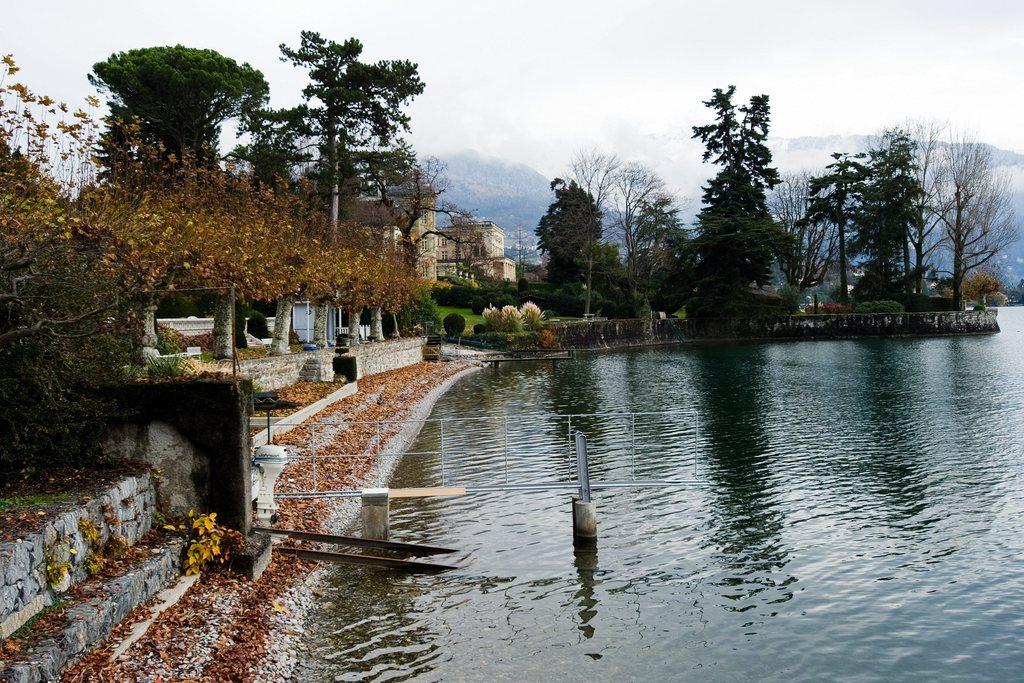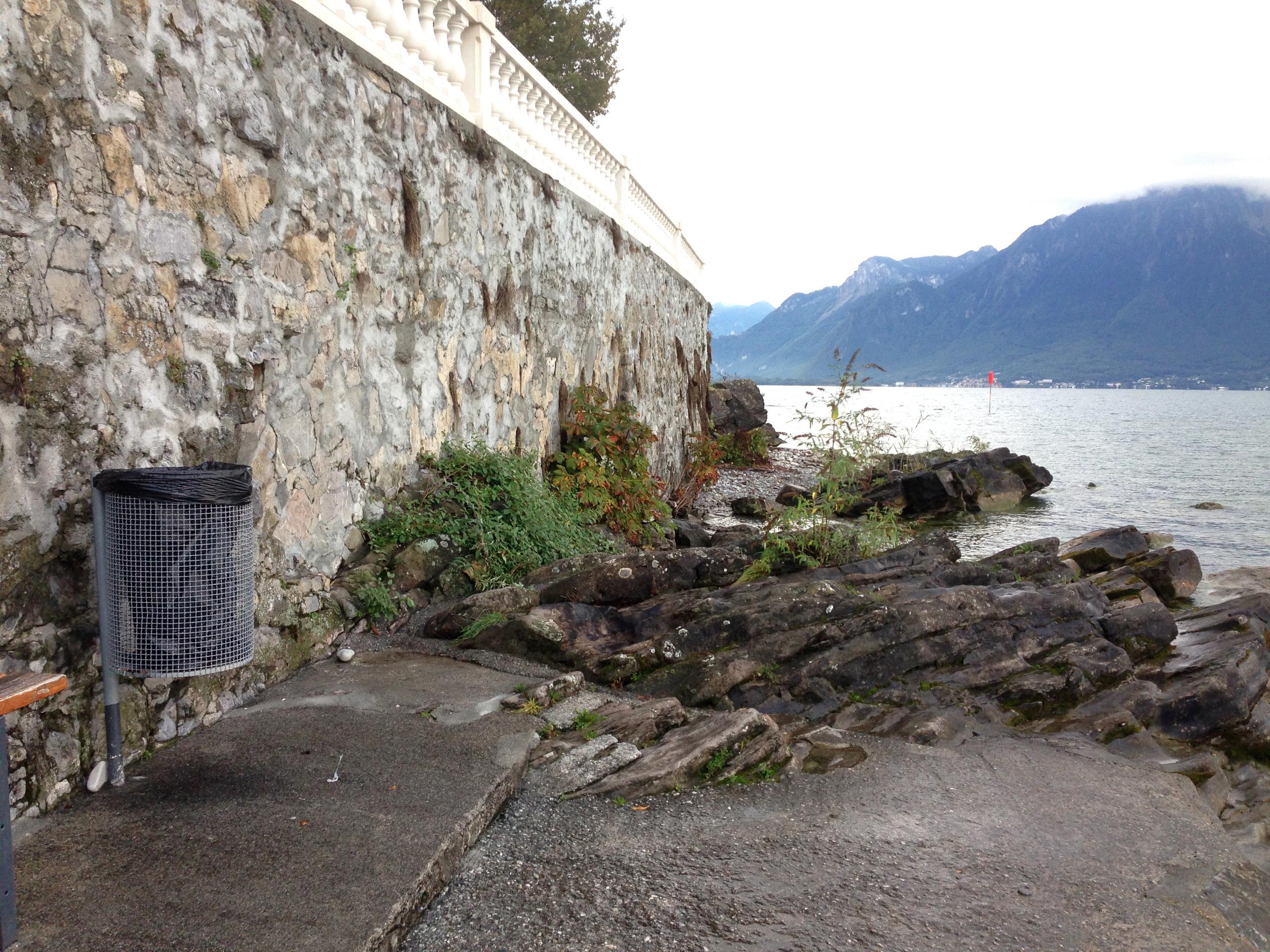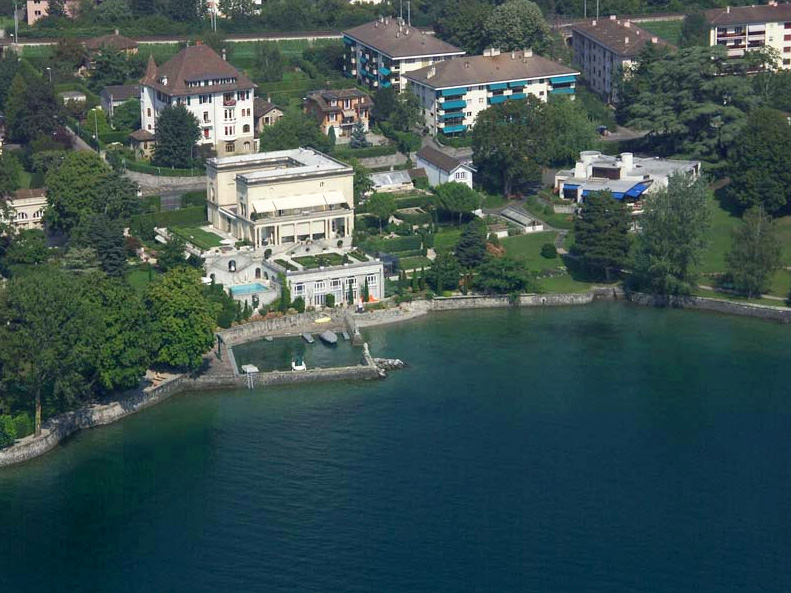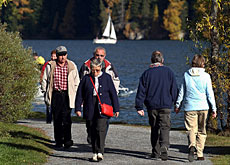Footpath impasse is a ‘slap in the face’ for voters

The Swiss vote on pretty much everything. But implementing controversial local ballot box decisions can be a major headache. Five years after La Tour-de-Peilz residents voted to build a public footpath along the shores of Lake Geneva, there is little visible progress.
From the town of Vevey on Lake Geneva, walkers can take a footpath that winds along the picturesque La Tour-de-Peilz shoreline past a tiny port and a stony beach, while admiring stunning views of the French Alps opposite.
But suddenly the trail then hits a dead end. Concrete appears to have run out. Ahead are slippery rocks poking through the clear deep water.
“We really enjoy walking along the lake and we’d really like to continue a bit further. It was something voted through, so I don’t understand what is going on,” declared Evelyn* out on a stroll with her husband.
With their route barred, the couple are forced to take a detour up to a main road to skirt around the 20-odd million-franc villas that line the lakeshore towards Montreux.
In theory, the detour should not be there. On November 28, 2010, 55% of La Tour-de-Peilz voters, a town of 10,500 residents, backed an initiative put forward by a local group of citizens to build a two-kilometre public footpath in front of the luxury lake properties.
Since then there has been little obvious progress. Critics say the local authorities, responsible for urban development, continue to drag their feet. In 2012, the town council, which has a majority on the right, voted against the local government’s feasibility study. The critics say the government’s plan was ill conceived deliberately, with high expropriation costs for owners, to ensure it sank.
“There is a serious inertia,” said Barbara*. “It’s linked to the communal elections in February 2016. The town council wants it to fail as there are so many private interests at stake.”

La Tour-de-Peilz officialsExternal link say the footpath proposal is progressing, albeit ‘painfully’.
“There are several partners who need to agree. The owners need to keep certain rights. There are also the cantonal water and fauna services. It requires a wide political will to implement it which is not there at the moment,” La Tour-de-Peilz mayor Lyonel Kaufmann told Swiss public television, RTS, in September.
A new study outlining several path options was presented to the Vaud Lakeshore Commission (CRL)External link for consultation in July. But getting a common position by the end of this year is not certain.
Nicole Rimella, head of the urban planning at La Tour-de-Peilz, personally opposes the new path. She said the commune was ‘obliged to advance’ but blamed the delay on members of the CRL who cannot agree on how to proceed.
“We keep taking one step forward and two backwards,” she said. “It’s a political issue, a battle between left and right.”
In its advisory role, the CRL maintains it is not holding things up. It says the ultimate responsibility is in the hands of La Tour-de-Peilz officials.
“We are in favour of the path but the solution needs to be proportionate,” said Philippe Hohl, head of Vaud’s water division. “Technically, it’s not complicated. But what is holding the project up is finding the right balance between a pathway which is not too close to private homes and which doesn’t impact on the landscape along the lake. It is a real clash between private and public interests.”
Tired of ping-pong
Tired of the endless delays and ping-pong, a local association (Rives du LacExternal link) has come forward with their own cheaper minimalist plan. This involves unlocking gates and fences that owners have installed along the shore, and, where possible, using the existing natural route over rocks and gravel beaches. They suggest installing several steps and attaching lightweight metal pathways to the lake walls. In all, this should cost CHF1.5 million, less than half the initial budget.
According to the association, public right of way exists on over half of the inaccessible 2-km stretch. It argues there is no need to expropriate the owners but to apply existing laws.
This Youtube video below (in French) produced by the association outlines their plan.
Rives du Lac President Geneviève Pasche described the current deadlock as a ‘slap in the face’ for local voters: “What’s the point in voting if the politicians just do what they feel like.”
In August 2013, the association appealed to the Vaud government, which issued a statement urging the local municipality to “act without delay”.
“But there is no coercion possible, as urban planning in Switzerland is always the responsibility of the communes which have to apply it,” bemoaned local Social Democrat councillor Jacques Vallotton.
Pasche echoed this: “They introduced this idea of the right to file a people’s initiative but they didn’t foresee any legal sanctions if the local authorities didn’t fulfil the demands of the initiative.”
Andreas Ladner, a political scientist at the University of Lausanne, said in theory critics could go to the courts, but it would be very hard to prove the authorities were obstructing construction of the path.
In his eyes, the only possible sanction, and the fastest way of getting things changed, would be to ‘make it an issue at the forthcoming local elections’.
Whatever happens, the footpath is likely to take years to be completed. According to Vallotton, the planning phase is expected to last until 2022. Under the traditional democratic system, Swiss citizens have a right of say over urban planning decisions. Wealthy lakeside owners and other opponents are expected to lodge appeals arguing the path infringes upon their rights.
*names changed
It is estimated that only half of the shores of Swiss lakes, such as Zurich, Geneva and Constance are accessible to the public. According to a survey in 2007, 61.4% of Swiss people want unrestricted access to the lakeshores. This figure rises to 71.6% in French-speaking regions, compared with 58% in German-speaking areas and 80% for young people.
A complex body of laws governs access to Swiss lakeshores and riversides. According to the association Rives PubliquesExternal link, which defends public access, lakeshores and riversides have been part of the public domain for over 100 years. The association argues that local authorities rarely apply the laws to return what has been “confiscated” by private landowners.
But this view is challenged by owners and by the Federal Spatial Development Office, which in 2008 declared Swiss residents could not claim right of access to lake and river waterfronts. According to the government’s legal experts, federal legislation does say that access to lakeshores and riversides should be possible, but does not guarantee it.

In compliance with the JTI standards
More: SWI swissinfo.ch certified by the Journalism Trust Initiative




You can find an overview of ongoing debates with our journalists here. Please join us!
If you want to start a conversation about a topic raised in this article or want to report factual errors, email us at english@swissinfo.ch.